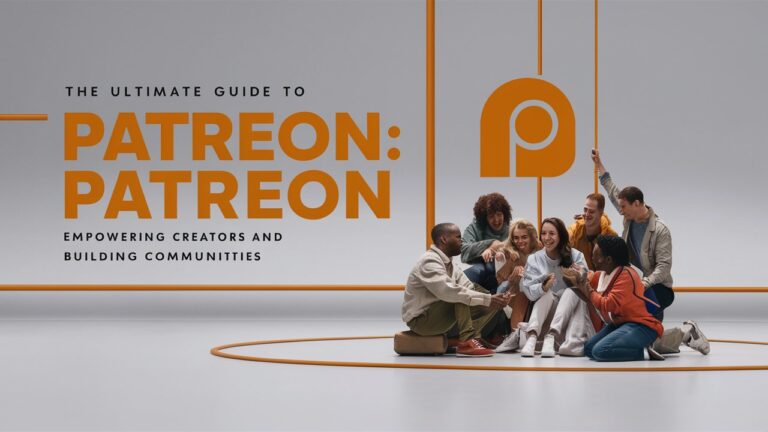Introduction
In the digital age, creators—artists, writers, musicians, podcasters, and more—are redefining how they monetize their passions. Traditional revenue streams like sponsorships or ad-based models often come with limitations, leaving creators scrambling for stability. Enter Patreon, a membership platform that bridges the gap between creators and their audiences. By enabling fans (or “patrons”) to support creators through monthly subscriptions, Patreon has revolutionized the creator economy. This article dives deep into how Patreon works, its benefits, challenges, and strategies for success, while answering common questions about this transformative platform.
1. What Is Patreon?
Patreon is a subscription-based platform designed to help creators earn recurring income by offering exclusive content, perks, and experiences to their supporters. Founded in 2013, it empowers creators to build sustainable careers by fostering direct relationships with their audiences. Unlike ad-driven platforms like YouTube, Patreon allows creators to monetize their work without relying on algorithms or third-party advertisers. Instead, patrons voluntarily subscribe to tiers that grant them access to behind-the-scenes content, early releases, merchandise, or personalized interactions. This model benefits both parties: creators gain financial stability, while patrons feel more connected to the creative process.
2. How Does Patreon Work?
Patreon operates on a membership model where creators set up subscription tiers with varying rewards. Here’s a breakdown:
- Creator Setup: Creators design tiers (e.g.,
- 5/monthforexclusiveposts,
- 5/monthforexclusiveposts,20/month for live Q&A sessions). They outline rewards for each tier, such as digital downloads, shoutouts, or physical products.
- Patron Subscriptions: Fans choose a tier and pay monthly or per-creation (e.g., per podcast episode). Payments are processed securely through Patreon, which charges patrons automatically.
- Content Delivery: Creators share exclusive posts, videos, or messages directly with patrons via Patreon’s dashboard or integrated platforms like Discord.
Patreon deducts a 5–12% platform fee, plus payment processing charges. Creators retain approximately 85–90% of their earnings, making it a cost-effective alternative to traditional crowdfunding.
3. Benefits of Patreon for Creators
For creators, Patreon offers unparalleled advantages:
- Stable Income: Monthly subscriptions provide predictable earnings, reducing reliance on inconsistent ad revenue or one-time sales.
- Creative Freedom: Without advertiser constraints, creators can produce authentic content aligned with their values.
- Community Building: Patreon fosters a loyal community. Creators interact directly with patrons through comments, polls, or live streams, deepening engagement.
- Analytics Tools: The platform provides insights into patron demographics and revenue trends, helping creators refine their strategies.
For example, a podcaster might use Patreon to offer ad-free episodes, while a visual artist could share time-lapse videos of their work.
4. Benefits of Patreon for Patrons
Patrons aren’t just passive supporters—they gain unique value:
- Exclusive Content: Access to content unavailable elsewhere, like bonus episodes, tutorials, or member-only forums.
- Direct Impact: Patrons know their contributions directly fund the creators they love, fostering a sense of ownership in their success.
- Personalized Interaction: Higher tiers often include perks like personalized messages, signed merchandise, or voting rights on future projects.
This symbiotic relationship turns casual fans into dedicated advocates.
5. Tips for Success on Patreon
Launching a successful Patreon requires strategy:
- Consistency: Regularly update your page with high-quality content to retain patrons. A stagnant page leads to cancellations.
- Tier Structure: Offer clear, enticing rewards. A
- 5tiermightincludeearlyaccess,whilea
- 5tiermightincludeearlyaccess,whilea50 tier could feature one-on-one coaching.
- Promotion: Promote your Patreon across social media, email newsletters, and existing platforms like YouTube. Cross-promotion is key.
- Transparency: Share goals (e.g., “100 patrons = a new series”) to motivate support.
Creators like Philosophy Tube and Chapo Trap House have thrived by blending niche content with community engagement.
6. Challenges of Using Patreon
Despite its perks, Patreon isn’t without hurdles:
- Income Variability: New creators may struggle to attract patrons initially, leading to financial uncertainty.
- Platform Fees: While lower than many alternatives, fees can add up for creators with smaller followings.
- Content Pressure: Patrons expect consistent rewards, which can lead to burnout if not managed.
Creators must balance authenticity with patron expectations to sustain long-term growth.
7. Frequently Asked Questions (FAQs)
Q: Can patrons cancel subscriptions anytime?
A: Yes. Patrons can cancel or change tiers at any time, and they’ll retain access until the billing cycle ends.
Q: Does Patreon take a cut of earnings?
A: Yes. Patreon charges 5–12% of monthly income, plus payment processing fees (around 2–5%).
Q: Can I use Patreon alongside other platforms?
A: Absolutely. Many creators use Patreon with YouTube, Twitch, or Substack to diversify revenue.
Q: Is Patreon only for artists?
A: No! Educators, gamers, nonprofits, and even fitness coaches use Patreon successfully.
Conclusion
Patreon has redefined the creator economy by prioritizing direct relationships over impersonal transactions. For creators, it offers financial stability and creative autonomy; for patrons, it provides insider access and a deeper connection to the work they love. While challenges like income variability exist, strategic planning and authentic engagement can turn Patreon into a powerful tool for sustainable growth. Whether you’re a creator seeking independence or a fan eager to support innovation, Patreon bridges the gap—one subscription at a time.
This comprehensive guide equips you with the knowledge to navigate Patreon confidently. Now, go forth and create (or support)!
